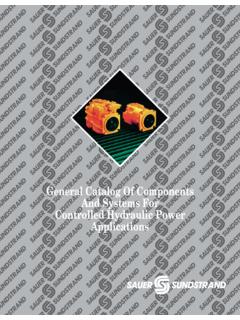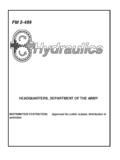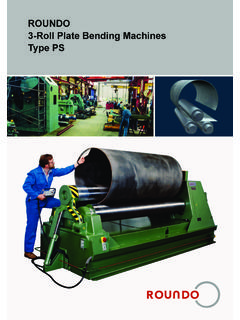Transcription of AXIAL PISTONS UNITS. BASIC PRINCIPLES. GENERAL ...
1 - AXIAL PISTONS UNITS. BASIC PRINCIPLES. - GENERAL INSTRUCTIONS FOR THE IDENTIFICATION OF FAILURES IN HYDROSTATIC TRANSMISSIONS. - INSTRUCTIONS FOR THE ADJUSTMENT OF THE HYDROSTATIC MOTORS BOSCH-REXROTH . FAILUREPOSSIBLE CAUSECHECKLOCATIONCORRECT VALUESOil Level is lowOil levelOil tankSuction hose is bent or squashedSuction hoseHydraulic oil cartridge is clogged Depressor marked in vacuum gaugeSuction filter< 0,3 barFaulty coupling Motor or pump couplingPre-load pump turns counterwise to engineFaulty pre-load pumpFaulty oil motorDirectional solenoid does not workResistance and voltage.
2 Control box (SAUER) Directional solenoids in pumpInching is seized, disconnected or badly set (SAUER)Throw and connections Pedal and electric connectionsFaulty oil strainerFaulty oil suction Sealing of tubes, connectors and suctionOil connectionsOil is air-emulsified or Oil level is low Oil level, sealing of pipes / hoses, fittingsOil tank, fittingsVacuum filter is cloggedDepressor marked in vacuum gaugeVacuum filter< 0,3 barInching is seized, disconnected or badly connected (SAUER)Potentiometer, linkage and connectionsPedal and electric connectionsINSTRUCTIONS FOR THE IDENTIFICATION OF FAILURES IN HYDROSTATIC TRANSMISSIONS20 24 barThe machine does not move neither forward nor reverseNon instant motion response, abnormal noiseLoad pressurePressure intake with a gauge on pump's port M3 (SAUER GROUP) or S (BOSCH-REXROTH GROUP)FAILUREPOSSIBLE CAUSECHECKLOCATIONCORRECT VALUESLow engine power or faulty engineEngine does not accelerate at max.
3 LoadEngine85 95 % max rpm. of engineHigh pressure-limit is set too lowWorking pressureWorking pressure ports in pumpRecommended max. Pressures: 345 or 410 is seized (SAUER)Potentiometer / linkagePedal< 0,3 barEngine does not work at nominal level orHaul of accelerator leverEngine85 95 % max rpm. of engineLow load pressureLoad pressurePressure intake with a gauge on pump's port M3 (SAUER GROUP) or S (BOSCH-REXROTH GROUP)20 24 barInching is seized (SAUER)Potentiometer / linkagePedalM4, M5 (SAUER) or Xa, Xb (BOSCH-REXROTH) Piloting hoses of hydrostatic motor are chartConnectionsHydraulic Oil overheatingDirt in radiatorRadiator oilLow oil levelOil levelFaulty oilOil degradation an pollutionSuction line is not sealedSealing for hoses, fittings and cartridgeOil connectionsFaulty high pressure relief-valvesWorking pressureWorking pressure ports in pumpRecommended max.
4 Pressures: 345 or 410 is cloggedDirt in radiatorEngine is overloadedLow traction powerINSTRUCTIONS FOR THE IDENTIFICATION OF FAILURES IN HYDROSTATIC TRANSMISSIONSH ydraulic oil overheatingOil tankFAILUREPOSSIBLE CAUSECHECKLOCATIONCORRECT VALUESMax. Engine RPM is higher than recommendedMax. RPM on the engineEngineFaulty hudrostatic motor. Does not move to max. runningM4, M5 (SAUER) or Xa, Xb (BOSCH-REXROTH) Piloting hoses of hydrostatic motor are ChartOil connectionsLow engine powerHaul of accelerator leverEngineM4, M5 (SAUER) or Xa, Xb (BOSCH-REXROTH) Piloting hoses of hydrostatic motor are ChartOil connectionsFaulty hudrostatic motor. Does not move to min. overspeedInsuficient accelerationINSTRUCTIONS FOR THE IDENTIFICATION OF FAILURES IN HYDROSTATIC TRANSMISSIONS Instruction for the adjustment of hydrostaticmotorsCH 250 p/n : the instructions for the adjustment of the maximum speed on forklifts CH 250assembled with motor p/n The adjustment is performed with the stud andthe lock nut in detail "A" on picture 1.
5 Sometimesthey can be protected with a plastic cap, whichshould be removed to stud height must be checked with an slidecaliper (measurement "A" on picture 1). If theheight doesn't fit with the regulation height forthe machine model which will be assembled, itshould be regulated with the propermeasurement in chart adjust, loose the lock nut with a 19mmwrench (picture 2) adjusting the stud with a 5mmAllen key (picture 3), until desired height isreached. Once adjusted, tight the lock nutholding the stud with the Allen key. Picture 1 Detail A Picture 2 Picture 3 REXROTH HYDRAULIC MOTORA6VM80DA1/63W-VZB027B AUSA p/n : (model)MeasurementAmmSpeedKm/hCH250/x426 ,520 Chart 1 IndustrialHydraulicsElectric Drivesand ControlsLinear Motion andAssembly TechnologiesPneumaticsServiceAut oma t ionMobileHydraulicsTraining Mobile HydraulicAxial Piston UnitsBasic Principles and Function31Ba sic of Hydraulic Open Closed Circuit2 Principles of bent - axis Description of Principles of Rotary Group 40o -Tapered Piston.
6 bent - axis Rotary Examples of Swashplate Description of Principles of Rotary Group Swashplate Rotary Examples of Symbols3 Component sA Selection of Typical Models fromthe indivdual Product Modelstoof bent - axis of Control DevicesPage4-56-1112-1718-314 AXIAL Piston UnitsBasic Principles1 BASIC of Hydraulic CircuitFor the hydraulic engineer, there are three BASIC types of circuit to consider:Open circuit /Open circuit /Open circuit /Open circuit /Open circuit / Closed circuit Closed circuit Closed circuit Closed circuit Closed circuit / Semi-closed circuitIn the following we look at open and closed circuits in some details. The semi-closed circuit is a mixture of these two types ofcircuit and is used in applications where volume compensation via prefill valves is necessary.
7 ( when using a single rod cylinder) CircuitOpenOpenOpenOpenOpen circuit normally means the case where the pump suctionline leads below a fluid level whose surface is openopenopenopenopen to atmosphericpressure. Maintenance of a pressure balance between the air inthe hydaulic tank and the air in the atmosphere guarantees goodpump suction characteristics. There must be no resistance in theinlet line which might cause pressure to drop below the so-called suction head/suction piston units are self-priming; in certain special cases, howe-ver, a low pressure is applied to the suction openopenopenopenopen circuit hydraulic fluid is fed to the user via directionalcontrol valves and returned to the tank in the same features of the ooooopppppeeeeennnnn circuit are: Suction lines - short length, large diameter Directional control valves - flow-related sizes Filter / cooler - flow-related sizes Tank size - a multiple of the max.
8 Pump flow in litres Pump arrangement - adjacent to or below the tank Drive speeds - limited by the suction head Load maintained in return by valvesThe openopenopenopenopen circuit is standard in many industrial and mobileapplications - from machine tools, through press drives to win-ches and mobile CircuitThe way to the complete Hydraulic-System:(Explanation of symbols, see page 5) BASIC system withhydraulic pump andhydraulic motor (orcylinder).Single direction ofinput, output and directional controlvalve allows reversalof the direction ofrotation or of movementat the output speedis achieved byinstallation of a flowcontroller for pressure reliefvalve (DBV) protectsthe system , the fixed pumpand flow controllerhave been replacedby a variable valvefunctions have beenadded, free-wheeling of the , cooler andother accessoriesare also = variableInput speedn = speedn = variableDBVL ifting speedv = variableFlow Q = size (litres)
9 Input speedn = speedn = speedv = lineFlowQ = speedn = speedn = speedv = = variableInput speedn = speedn = variableDirection ofpositionDirectionof liftingDBVL ifting speedv = CircuitA hydraulic system is described as closedclosedclosedclosedclosed when the hydraulicfluid is returned from the user direct to the is a high pressure and a low pressure side, depending onthe direction of load (take-off torque at the user).The high pressure side is protected by pressure relief valves whichunload to the low pressure side. The hydraulic fluid remains inthe the continuous leakage from pump and motor (depen-dent on operating data) must be fluid is normally replenished by an auxiliary pump flan-ged direct onto the main pump which delivers a continuous,adequate supply of fluid (boost fluid) from a small tank via acheck valve into the low pressure side of the closed closed closed closed closed circuit.
10 Anysurplus flow of the boost pump, which operates in open circuit,is returned via a boost-pressure relief valve to the tank. Theboosting of the low pressure side enhances the features of the cccccloseloseloseloseloseddddd circuit for AXIAL piston units are: Directional control valves - small sizes for pilot operation Filter/cooler - small sizes Tank size - small, dimensioned to suit boost pump flowand volume of system Speed - high limiting values through boost Arrangement/mounting - position-flexible/optional Drive - completely reversible through centre position Load maintained - via the drive motor Feedback of braking powerClosed CircuitA Step-by-Step Guide:(Explanation of symbols, see below left)Pressure relief valves, one each for the high and low pressure sides,prevent the maximum permissible pressure from being leakage from pump and motor is led back to a small tank and mustbe replenished!









